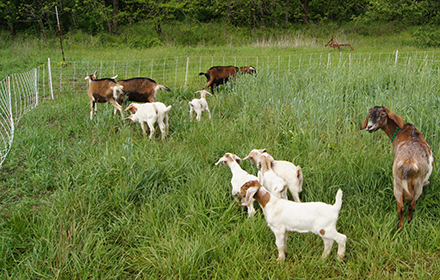| |

|
| Goats can be contained by electric fence, but they must be thoroughly and properly trained. (Photo by Chert Hollow Farm.)
|
|
Training Animals to Electric Netting is Essential
Portable netting is the easiest way to keep livestock moving about the landscape, but it’s very important to train all animals to these fences. Since they’re not as strong as permanent wire-mesh fences, their value and safety relies on the animal understanding and respecting the barrier. An animal which becomes entangled is at risk of injury or death through a combination of strangulation and shock stress.
Young lambs and kids are particularly vulnerable because their smaller heads fit easily through the fences’ openings as they explore the new world around them. Unlike a cattle panel, once an animal’s head is through a flexible net, it’s much harder for them to withdraw without entanglement. Meanwhile, the fence is delivering an electric pulse to the animal, a double-dose of danger!
There are several ways to mitigate this risk:
- Introduce livestock to the fence slowly and intentionally.
- Set up a test section inside of a permanent paddock and expose new stock to the electrified netting. When an animal is shocked, it will create an association between pain and fence that will linger in their mind. This temporary unpleasantness is well worth the long-term benefits for the animal.
- Remain in earshot when using electric fence with young animals. If you hear hollering, it’s easy to run down, disconnect the fence and free the animal before any permanent harm is done.
A similar process can be used with any new animals you introduce to your herd, or any problem animals that seem determined to test the fence. Simply watching your herd can help in identifying individuals who show less respect than you’d like.
|
|
|
|
